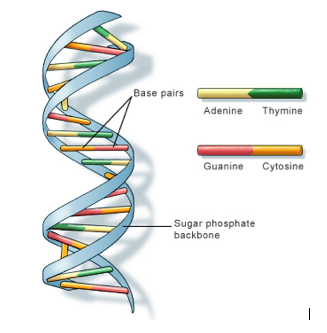GAMSAT Biology Macromolecules
If you’ve had a chance to look at the GAMSAT Biology Syllabus, you will notice Macromolecules is a subject that frequently pops up in the GAMSAT Section III.
In this blog post, we will briefly cover Biology Macromolecules below:
The four classes of biological molecules include carbohydrates, lipids, proteins and nucleic acids.
Carbohydrates
The term carbohydrate refers to both sugars and their polymers. Students should be aware of the following terms for the GAMSAT.
Monosaccharides: are the simplest carbohydrates and are also known as single sugars. Glucose is a common monosaccharide and is a major nutrient for cells. Cells extract the energy stored in the glucose molecule by a process known as cellular respiration.
Disaccharides: are double sugars that consist of two monosaccharides. Maltose is a disaccharide formed by the linking of two molecules of glucose.
Polysaccharides: can be storage polysaccharides or structural polysaccharides.
Starch: a storage polysaccharide of plants and is stored as granules in chloroplasts. Starch represents stored energy and can later be withdrawn by hydrolysis to provide the plant with energy. Animals store glucose as glycogen in the liver and muscle cells. The comparable molecule to starch in animals is glycogen. Starch is a polymer of alpha-glucose.
Cellulose: a common structural polysaccharide. Cellulose is a polymer of Beta-glucose and is found in plant cell walls.
Chitin: the structural molecules found in fungi and anthropods. It forms a tough, resistant material.
Nucleic acids
Two types of nucleic acids include:
Deoxyribonucleic acid (DNA)
DNA is found in the nuclear region of cells and contains the genetic information to create an organism. DNA is found as a double helix structure.
Ribonucleic acid (RNA)
RNA is identical to DNA, but differs in 3 main ways:
- RNA is single stranded.
- Carbon number 2 on the pentose of RNA is deoxygenated.
- RNA contains uracil instead of thymine.
There are three types of RNA:
mRNA: Messenger RNA delivers the DNA code for amino acids to the cytosol to prepare for the manufacturing of proteins.
rRNA: Ribosomal RNA forms ribosomes by combining with proteins. The ribosomes are responsible for directing the synthesis of proteins.
tRNA: Transfer RNA collects amino acids in the cytosol and transfers them to the ribosomes. At the ribosomes the tRNA is incorporated into the proteins.
REMEMBER: RNA is manufactured from a DNA template.
Nucleic acids
Nucleic acids carry information inside cells and are responsible for the production of a large number of proteins. They are long polymers of repeating subunits called nucleotides. Each nucleotide consists of a pentose sugar, phosphate group and an organic nitrogenous base.
Two types of nitrogenous bases occur in nucleotides:
Purines: Double-bonded rings found in DNA and RNA. The purines include adenine (A) and guanine (G).
Pyrimidines: Single-ring structure. The pyrimidine that is found in both RNA and DNA is cytosine (C). The pyrimidine that is found only in DNA is thymine (T) and the pyrimidine that is only found in RNA is uracil (U).
In a nucleic acid, the nucleotides are linked to each other via phosphodiester bonds. These bonds are formed between the phosphate of one nucleotide and the sugar of the next nucleotide.
DNA consists of two polynucleotide chains wrapped around each other along a single helical axis. The spiral shaped formed by DNA is termed a double helix. The base pairs on each polynucleotide chain run in opposite directions and are joined by hydrogen bonds between the nitrogenous bases.
The following shows base pairing in a DNA double helix:
The bases that participate in base-pairing are termed complimentary bases. Adenine can pair with thymine (DNA) and with uracil (RNA). Cytosine can only pair with guanine.
DNA (double-stranded) can be transcribed into RNA (single-stranded). DNA stores hereditary information and the RNA uses this information to create proteins via the sequencing of specific amino acids.
Proteins
In terms of the GAMSAT students should know that proteins have many different functions in cells. They can be used in enzyme catalysis, transport, defense, structural support, movement, regulation of genes, and storage of ions.
Proteins are polymers of amino acids. There are 20 amino acids. Proteins fold into different shapes based on their amino acid composition. Cells contain chaperone proteins, which help other proteins fold correctly.
Chaperones have previously come up in the GAMSAT and students should just remember that they assist in the folding of proteins.
If a protein’s environment is altered, the protein may change shape or completely unfold. This is known as denaturation. Proteins can become denatured as a result of changes in pH, ion concentration and temperature. Dentatured proteins are inactive and therefore cannot catalyse reactions.
The Central Dogma of gene expression is that DNA is transcribed to RNA, which is translated to amino acids. Many amino acids link up and form a protein.
Lipids
All lipids are insoluble in water and have a high proportion of non-polar C-H bonds.
Saturated lipids occur when all the internal carbon atoms in a fatty acid chain are bonded to at least two hydrogen atoms. Unsaturated lipids occur when a fatty acid has double (or triple) bonds between their internal carbon atoms.
If a fatty acid has more than one double bond it is termed polyunsaturated.
Most fats contain more than 40 carbon atoms. The fats produced by animals are mostly saturated, whereas plants mostly produce unsaturated fats.
Phospholipids are complex lipid molecules and are important as they form the core of all cell membranes in organisms. A phospholipid can be thought of as a triglyceride with a phosphate group replacing one of the fatty acids.
Glycerol structure should be memorized for the GAMSAT. It is a three-carbon alcohol and each carbon atom contains a hydroxyl group. Glycerol forms the backbone of phospholipid molecules.


